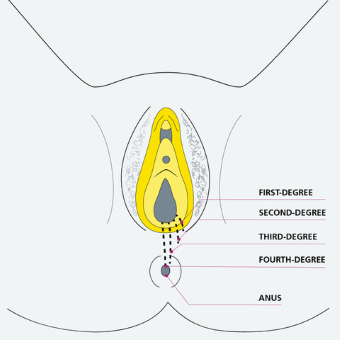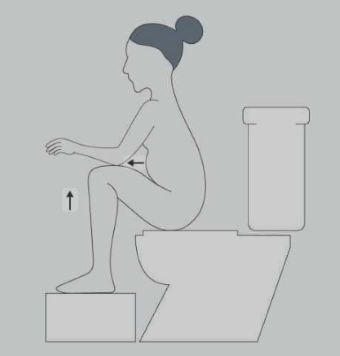This page has information for patients who have had a third and fourth degree tear during the delivery of your baby. These are called obstetric anal sphincter injuries (OASI).
This page explains the types of tears, how to look after yourself, and follow-up care.
What is a perineal tear?
Many women experience tears during childbirth, as the baby stretches the vagina and perineum (skin between the opening of the birth canal and anus). In the UK around 9 in 10 women who have a vaginal birth will have some degree of perineal trauma.
Types of perineal tear
- First degree tears are small skin-deep tears. They usually heal naturally.
- Second degree tears are deeper and affect the muscles of the perineum. They usually need stitches.
- An episiotomy is a cut made by a healthcare professional through the vaginal wall and perineum. This may be done if your baby needs to be born more quickly or if they need more space. Episiotomies can sometimes extend and become a deeper tear.
- Third degree tears extend into the muscle that controls the anus, and the anal sphincter. If this extends further into the lining of the anus or rectum this is a fourth degree tear.
- A rectal buttonhole is a rare injury when the anal sphincter doesn’t tear but there is a hole between the anus and vagina.

Why did I get a third/fourth degree tear?
They usually happen unexpectedly during birth. It is not possible to predict but you may be more likely to get one if:
- This is your first vaginal birth (about 6 in 100). If it is your second vaginal birth the risk is about 2 in 100.
- You are of South Asian heritage.
- Your second stage of labour is longer than expected (from when the cervix is fully dilated to birth).
- You needed assistance during delivery with forceps or a ventouse (vacuum assisted vaginal delivery).
- One of the baby’s shoulders gets stuck behind your pubic bone, delaying the birth. This is called shoulder dystocia.
- Your baby is large (over 4kg).
- You have had a third/fourth degree tear before (7 in 100).
It is important to identify a third/fourth degree to repair it properly. This will be done in hospital in theatre.
Will it cause any problems?
Most third/fourth degree tears will repair and won’t cause long-term problems. Some women have trouble holding in wind and a small number of women have leakage of faeces (poo).
What about stitches?
You will have stitches between your vagina and anus, and beneath the skin. They will eventually dissolve or soften and fall out. You may be able to feel them for up to 3 months.
You will likely experience pain/soreness for 4-6 weeks after giving birth, particularly when sitting or walking. Taking regular pain relief can help.
You can use ice on the area but make sure to wrap it in a clean, damp towel to protect the skin. Use it for 5-10 minutes and regularly check you are not causing ice burns.
You may want to use a travel cushion or two rolled up towels when sitting to elevate the perineum.
Stitches can irritate as healing happens, but this is normal. Passing urine (peeing) can cause stinging but pouring water over the area when urinating can help.
If you are worried about your wound or notice any bleeding from the tear, an abnormal or offensive smell, abnormal discharge, increased pain, you should see your healthcare professional. These might be a sign of infection and you may need antibiotics.
What can I do to help recovery?
Some simple steps can help healing and reduce the chance of developing complications.
Keeping the area around the tear and perineum clean
- Wash the area a few times a day, including after opening your bowels. The best way is to pour warm water over the area while sitting on the toilet. Allow the area to air dry or pat dry with clean toiler paper or clean towel.
- Always wipe from front to back. Use clean toilet paper for each wipe.
- We advise a bath/shower twice a day in clear water. Avoid soaps, shower gels, and cosmetic products as they can interfere with healing.
- Do not use talcum powder or tampons.
- You will be given antibiotics to take for 5 days to reduce the risk of infection.
- Change sanitary towels often, at least every 2-3 hours.
Opening your bowels (avoiding constipation)
Opening your bowels should not affect your stitches. For the first few days after your tear is repaired, control of your bowels may not be as good as before you had you baby.
- You will be given some medicine to soften your stool (poo) when you go home.
- Aim to drink at least 2 litres of water a day.
- Eat a healthy balanced diet including things like fruit, vegetables, cereals, and wholemeal bread.
- Avoid painkillers with codeine as they can cause constipation.
The best position to sit in when opening your bowels is with your feet on a stool like in the image below with your:
- Knees higher than hips.
- Lean forwards and put your elbows on your knees.
- Bulge out your abdomen.
- Straighten your spine.
- Take your time and don’t rush.
This helps straighten your bowel.

What can I do to help improve my bladder and bowel control?
You can strengthen the muscles around the vagina and anus by doing pelvic floor exercises. You should start these as soon as you can after the birth, as long as you don’t have a catheter in and you’ve had your first normal wee.
The next page has a brief description of how to do pelvic floor exercises and there are links in the back of this leaflet to further resources we have put together.
Doing the pelvic floor exercises
- Sit comfortably on a chair with your feet and knees apart.
- If it is more comfortable, lean over and rest your forearms on your knees.
- Relax and take a a few deep breaths.
- Try to keep your tummy muscles and bottom relaxed.
- If sitting is uncomfortable, try lying on your back or side.
Locating the pelvic floor
- Imagine you are trying to stop passing wind, at the same time as stopping the flow of urine.
- You should feel a sensation of “squeeze and lift” as you close up and draw up the muscles.
- Don’t worry if you can’t feel much to begin with, it can take some time but keep trying.
It is important you do not try and stop the flow of urine when you are on the toilet. This can cause problems with emptying the bladder.
How do I practice the exercises?
Begin practicing contracting and relaxing the pelvic floor muscles three times a day. Once you can feel the muscles working and feeling comfortable you can try doing the slow/quick contractions described on below.
It’s important to develop the two types of muscle activity, slow and fast. This is because the pelvic floor works to help us to ‘hold on’ when we need the toilet, but it also kicks in to protect us against sudden leakage during activity or during coughing, sneezing, or laughing.
Slow contractions
- Do the exercises on page 6 and try to hold the pelvic floor contraction.
- Start by aiming for 2-3 seconds and over, up to a maximum of 10 seconds.
- Rest for a few seconds, then repeat up to 10 times.
Quick contractions
- Contract the pelvic floor and let it go - do not hold on.
- Repeat up to 10 times.
How often should I do the exercises?
Aim to do one set of slow followed by one set of quick, three times a day. You can do this standing, sitting, or lying, but it may be easier to do it lying down at first.
It is good to contract your pelvic floor muscles during active movements such as when you’re lifting, coughing, or laughing, as this can help prevent any leakage.
When can I expect to return to usual activities?
Every woman’s recovery is slightly different, what you view as normal daily activity will differ. If you have a third/fourth degree tear, you should avoid strenuous activity and heavy lifting for 4-6 weeks. After this you can gradually increase your general activity.
We recommend waiting at least 12 weeks before doing any higher intensity exercise (like running and jumping), and advise you gradually return. You could try something like the NHS Couch to 5k app.
When can I be intimate (have sex) with my partner again?
Many women are anxious about experiencing discomfort when being intimate again after giving birth, particularly if you have had a perineal tear.
When your stitches have healed and bleeding has stopped, you can have sex again when it feels right for you and your partner. It might feel uncomfortable at first but this should not persist.
After 6 weeks if your stitches have healed, you can start some gentle perineal massage to help improve comfort (see link at end of leaflet). You can also use a lubricant when having sex, as the vagina may feel dryer because of post-natal hormones, especially if you are breastfeeding.
It is possible to get pregnant again soon after giving birth, even if you haven’t had a period. It is important to use contraception, and you can discuss your option with your healthcare professional.
What follow-up arrangements should I expect?
If you have had a third/fourth degree tear, a member of the pelvic health physiotherapy team should contact you in the days after delivery. Or you may be given advice on the ward.
You will have contact again around 6 weeks after giving birth. If you are experiencing symptoms of pelvic floor dysfunction at this point you will be offered further treatment.
You will also be reviewed in the OASI clinic. These appointments are with the specialist, multi-disciplinary team between 3-5 months after giving birth. At this appointment you will have some tests to check the muscles of the anal sphincter and have the chance to ask any questions you have. Find out more about the OASI clinic and what to expect here:
Obstetric anal sphincter injury (OASI) clinic | North Bristol NHS Trust
Will I be able to have a vaginal birth again?
Most women have no long-term problems following their tear, and can have a vaginal birth in the future. Currently there is limited evidence to suggest is you are at increased risk of having another tear. It is suggested that women who have a third/fourth degree tear in their first birth have 7-10 in 100 chance of having a similar one in their next vaginal birth.
In any future pregnancy you will be referred to a consultant in the antenatal clinic. The consultant will discuss your options and help create an individualised birth plan taking your choices into account. You will discuss the options for delivery to help you make a decision suitable for you.
It is helpful to do perineal massage in the last couple of months of pregnancy as this reduces the risk of another tear.
Useful NBT videos
Useful phone numbers
Southmead Hospital Bristol
Antenatal Assessment Unit, Southmead Hospital
Central Delivery Suite, Southmead Hospital
Cossham Birth Centre
Day Assessment Unit, St Michael’s Hospital
Delivery Suite St Michael’s Hospital, Bristol
Day Assessment Unit, Royal United Hospital, Bath
© North Bristol NHS Trust. This edition published October 2024. Review due October 2027. NBT002127
Support your local hospital charity

See the impact we make across our hospitals and how you can be a part of it.
Obstetric anal sphincter injury (OASI) clinic
Information about the OASI clinic including what to expect at your appointment.
